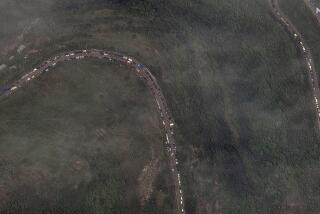Environment : Central Asia Peaks Alluring--and Treacherous : Frontier law prevails in some hoped-for tourist areas of former Soviet republics. Uncontrolled visits may hurt cultures and wildlife.
- Share via
Welcome to the middle of nowhere, 12,000 feet up.
Once seemingly lost in the forbidding hinterland of the Soviet Union, the mountain peaks of Central Asia are now being hailed by many as the “next Nepal”--a high-altitude mecca for adventurous travelers in search of exotica, beautiful scenery and an adrenaline rush to chase away the ennui of urban living.
From hang-gliding off 24,590-foot-high Communism Peak in Tajikistan to backpacking across isolated alpine pastures in Kyrgyzstan, more and more outdoor buffs are discovering the thrills to be found in the Pamir and Tien Shan mountains.
But alongside the majesty of nature exist the human traumas of poverty and acute political strife--all of which throws Central Asia’s potential to become a premier wilderness recreation area into grave doubt.
The fate of nature itself here in one of the world’s last unspoiled mountain regions is also threatened by the upheavals rocking the region. According to a group of international park specialists, the quandary faced by these infant Central Asian nations is a familiar one for many Third World countries: how to satisfy the government’s desire for tourist revenues without risking destruction of the very wilderness that attracts foreign visitors in the first place.
Kazbek Valiev, a 20-year climbing veteran from Kazakhstan, exudes enthusiasm when he describes the Pamir and Tien Shan mountains that jut up impressively from Central Asia’s vast, arid landscape.
“Our mountains contain some of the highest, most beautiful peaks in the world,” boasted Valiev, who has scaled Mount Everest and now runs the Khan Tengri Mountaineering Firm in Alma-Ata, Kazakhstan, which organizes climbing expeditions for foreign and local sportsmen.
“For climbers, the Pamirs are much more accessible and less populated than (mountain peaks) in Nepal,” Valiev said.
Recent unrest in Tajikistan, however, has sent aftershocks of fear across the entire region, Valiev said in his paper-strewn office. “Our foreign clients are scared away from here, even though the fighting is hundreds of miles away.”
Tajikistan Foreign Minister Khudoberdi Kholiknazarov, himself a native of the Pamir region, acknowledges the yawning gap between his country’s tourist ambitions and the acute problems plaguing its development.
“Our country could be a premier tourist destination given its magnificent landscape,” he said in an interview in the Tajik capital, Dushanbe. “Unfortunately, we are still fighting to build a democracy here.” Moreover, Kholiknazarov said, “we have very little experience or knowledge of how to do business in the Western way.”
Problems encountered by wilderness travelers in Central Asia reflect the severe birth pains plaguing these newly independent states. Experienced hikers tell tales of wide-scale corruption, logistical nightmares, incompetence and frontier law.
Imagine, for instance, the horror-stricken faces of a group of American and Russian hikers as they watched the helicopter pilots who were flying them over 10,000-foot peaks in Tajikistan calmly gulp tin cups brimming with vodka.
Or consider the weeklong hiking expedition that crossed Saryboulak Pass from Kazakhstan into Kyrgyzstan this autumn. What should have been a peaceful journey into a high-altitude paradise began with a three-day search for enough gasoline so that a rickety old Soviet army ambulance could make the six-hour ride from Alma-Ata to the trail head.
En route, the hikers had to negotiate concrete roadblocks on the winding dirt road erected by villagers eager to extort “tolls” from passersby. And at road’s end, they were met by the local welcoming committee--a thuggish-looking pair of Kazakhs who took it upon themselves to grant or deny the hikers access to “their” wilderness. A bottle of vodka proved suitable tribute.
The local powers-that-be proved not so accommodating to a group of Japanese climbers who were scaling the peaks of Kyrgyzstan last summer. The climbers found themselves stranded, without extra supplies, for nearly a week on an isolated 14,000-foot peak because the helicopter firm that was to ferry them down refused to swallow the increased price of fuel needed for the return flight. Hungry and enraged, the Japanese finally agreed to pick up the higher fee.
“It’s definitely an ‘every man for himself’ mentality now,” said Frith Maier, director of Russian and Central Asia tours for Recreational Equipment Inc. (REI) Outfitters of Seattle.
According to Maier, an energetic and tanned young woman who has led trips in the former Soviet Union for the last five years, trekking in Central Asia used to be a relatively cheap and simple affair before the empire’s breakup. Giant tourist bureaucracies in Moscow made all the decisions for foreign customers, and local leaders had no choice but to obey.
But those days are gone. Central authority in the newly independent states of the region is rapidly losing its force in out-of-the-way areas, leaving local bureaucrats in control of how wilderness lands are used.
“Remote mountain areas have now become the personal fiefdom of some local honcho eager to line his pockets with hard-currency bribes,” said Maier, who added that in some areas, REI pays an average of $50 per head to corrupt local bureaucrats for permission to hike across wilderness.
As the old Soviet government tourist monopoly opens up to allow private competition, some say that industry standards have slipped.
“Soviet climbing guides were among the best and most experienced in the world,” said Howard Cooper, a native Coloradan who has trekked through the Himalayas.
As a client you knew you were in good hands because Soviet guides had to meet strict mountaineering standards, he said. But “now you have to be self-reliant and really know what you’re getting into. God forbid you get hurt.”
Another concern is that as the new governments of the region scramble to bolster their feeble economies, greed and short-term priorities will prevent them from formulating a rational land-management strategy.
“Governments here don’t view a pristine environment as a valuable commodity,” said Oleg Panfilov, a local Russian journalist and ethnographer in Dushanbe. “There is absolutely no political constituency in Tajikistan, for example, for protecting our wilderness or the traditional communities that live there.”
Panfilov conceded that politicians may not have the “luxury” to think about issues like environmental protection in the midst of civil wars and other ethnic unrest.
Nor is the environmental example set by the Soviets anything to imitate. Maier said that the old concept of tourism was to lure dollar-spending foreigners by “coming into some pristine wilderness area and building a five-star hotel with bars and big-screen television. Most officials here still don’t understand that our clients pay money to have exactly the opposite type of experience.”
Some believe that the region’s very backwardness leaves room for hope. “This area is at an incredibly raw stage in its development,” said Tyler Norris, president of the nonprofit Kuhiston Foundation--an organization trying to persuade Tajik officials to set aside a nationwide system of protected parklands.
The argument that Norris--a community activist and resident of Boulder, Colo.--uses on revenue-hungry bureaucrats is pure enlightened self-interest. “We tell them they’re shooting themselves in the foot if they destroy the very environment that attracts foreign tourists in the first place,” said the avid outdoorsman and frequent visitor to Tajikistan.
But others are skeptical. “The pressure is on for the fast buck from tourism,” Maier said. “Whether those in power will have the vision and authority to protect this incredible, unique landscape is still a very big question.”
Tall, Taller, Tallest
Peaks in Pamir and Tien Shan ranges are lower than Mt. Everest, the world’s highest, but they tower over Mt. McKinley. Everest, Nepal/Tibet: 29,028 feet Communism, Pamir range: 24,590 Pobedy, Tien Shan range: 24,406 Lenin, Pamir range: 23,405 Revolution, Pamir range: 22,882 Karl Marx, Pamir range: 22,058 Mt. McKinley, Alaska: 20,320 SOURCE: World Almanac 1992
More to Read
Sign up for The Wild
We’ll help you find the best places to hike, bike and run, as well as the perfect silent spots for meditation and yoga.
You may occasionally receive promotional content from the Los Angeles Times.






